Building Blocks I & II: Nucleotides
1/39
Earn XP
Description and Tags
• Describe the biochemical principles of ATP, NADH and FADH2 and their roles in cellular respiration. • Recall the role of regulatory nucleotides
Name | Mastery | Learn | Test | Matching | Spaced |
|---|
No study sessions yet.
40 Terms
What are the five main roles of nucleotides in cells?
Structural components for DNA and RNA (purines, pyrimidines)
energy carriers (ATP, NADH, FADH2),
synthesis & protection (NADPH),
a central point of metabolism (acetyl CoA),
signal transduction (cAMP, cGMP)
What are the three components that make up a nucleotide?
A nitrogen-containing base (either a purine or pyrimidine)
a pentose (5-carbon sugar, either ribose or deoxyribose)
one, two, or three phosphate groups attached at the 5' carbon
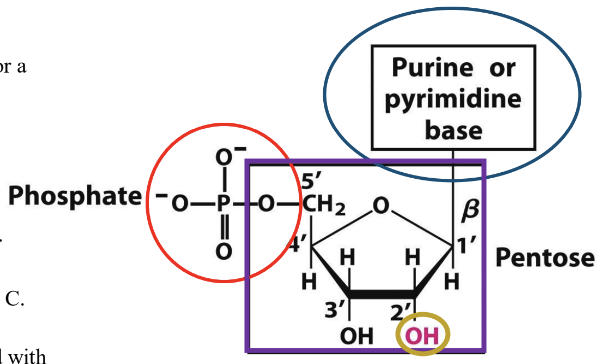
what is purine vs pyrimidine base
Purines are nitrogenous bases characterized by a two-ring structure, including adenine and guanine, while pyrimidines are single-ring bases, including cytosine, thymine, and uracil.
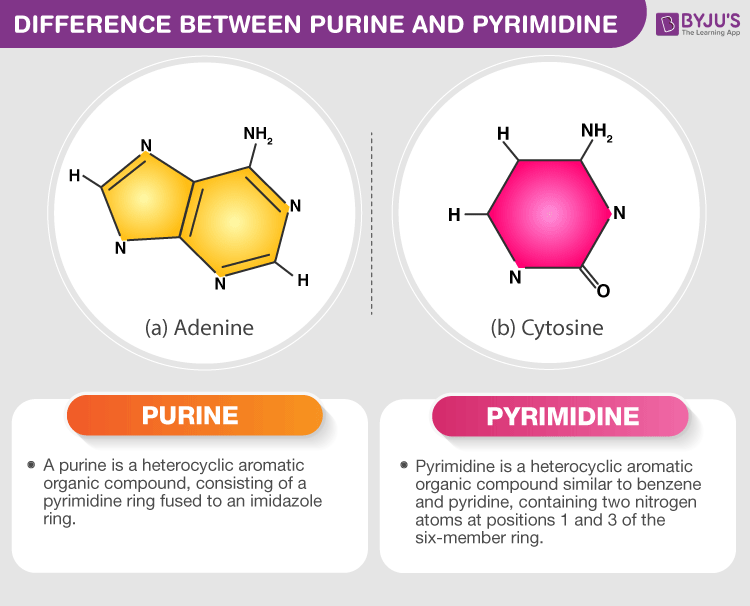
What is the structural difference between RNA and DNA at the 2' carbon of the pentose sugar?
RNA (ribonucleic acid) has an OH group on the 2' C, while DNA (deoxyribonucleic acid) has this OH group replaced with just H on the 2' C.
What is the difference in structure between pyrimidines and purines?
Pyrimidines have a single ring composed of four carbon and two nitrogen atoms, while purines have a double-ring structure.
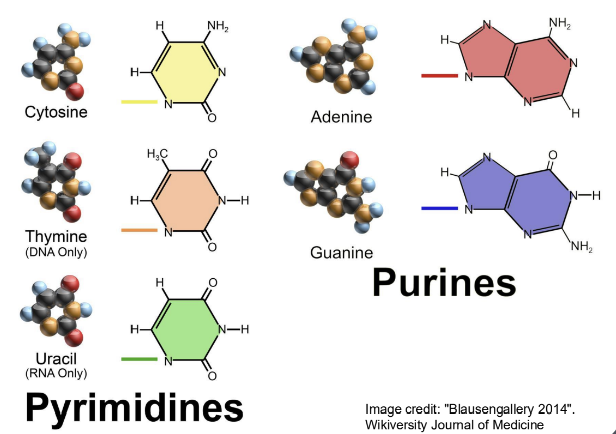
Name the common pyrimidine bases found in nucleic acids.
Cytosine, Thymine (in DNA), and Uracil (in RNA).
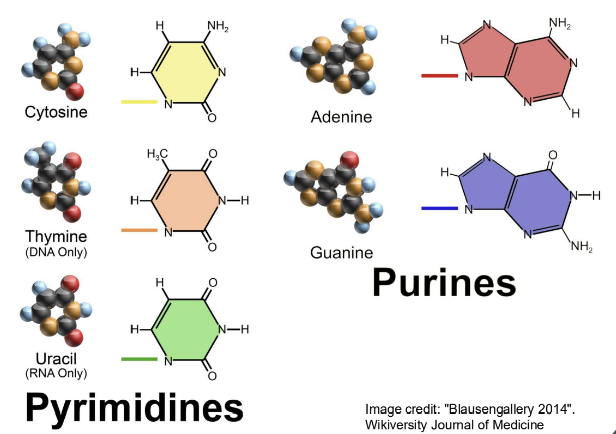
Name the common purine bases found in nucleic acids.
Adenine and Guanine.
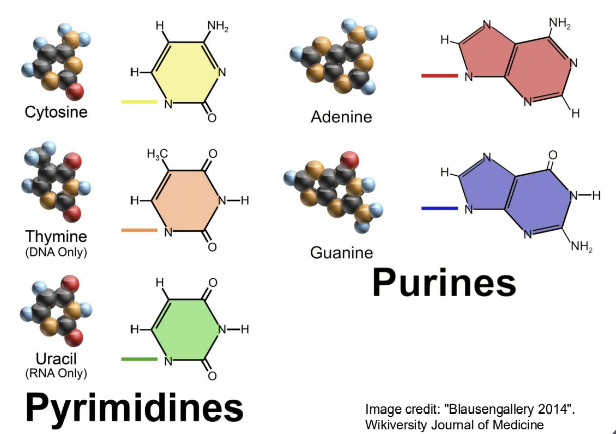
What is ATP commonly known as in the cell?
The cell's energy 'currency'.
What type of bonds link the phosphates in ATP and why are they important?
Phosphoanhydride bonds, which are high-energy bonds.
nucleotides carry chemical energy in cells
function of cell metabolism that allows for energy transfer and storage, enabling various cellular processes. Nucleotides serve as the energy currencyfor reactions, primarily through ATP

How much energy (under standard conditions) is released by the hydrolysis of an anhydride bond in ATP?
About 30 kJ/mol.
what is ATP
adenosine triphosphate
adenosine - adenine and the sugar
phosphates linked by phosphoanhydride bonds-high energy, cell’s energy “currency”
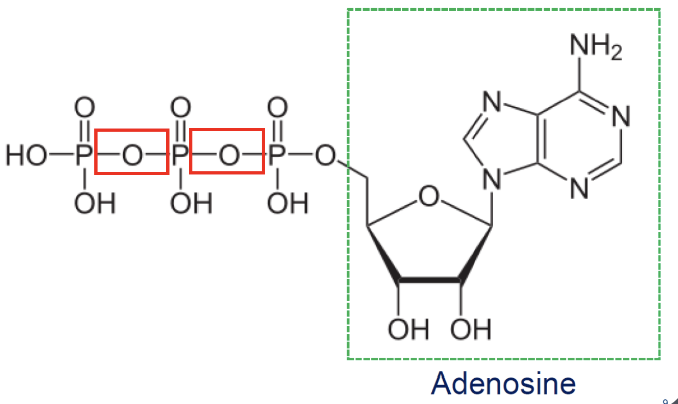
adenosine triphosphate (ATP)
phosphates linked by phosphoanhydride
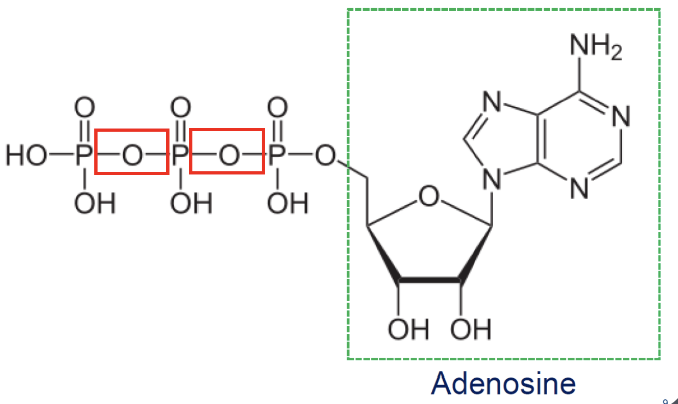
tell me about ATP bonds
hydrolysis of the ester linkage yields about 14kJ/mol under standard conditions
hydrolysis of each anhydride bond yields about 30kJ/mol
ATP needs to be regenerated (recycled) from ADP and P
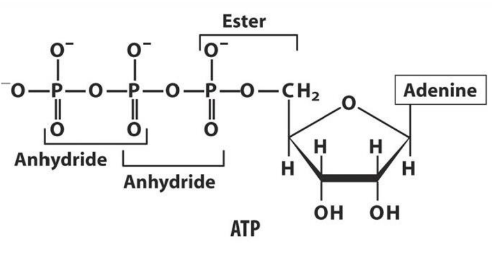
By what primary processes is ATP regenerated from ADP and inorganic phosphate (Pi)?
Glycolysis and Oxidative Phosphorylation.
Roughly how many times is each ATP molecule recycled in a human body per day?
Each ATP molecule will be recycled 500-750 times in a day.
Where does glycolysis occur in the cell and what are its net products?
Glycolysis occurs within the cytosol
2 ATP molecules hydrolysed to ADP
4 ATP molecules regenerated from ADP (two per pyruvate)
Also get two NADH molecules
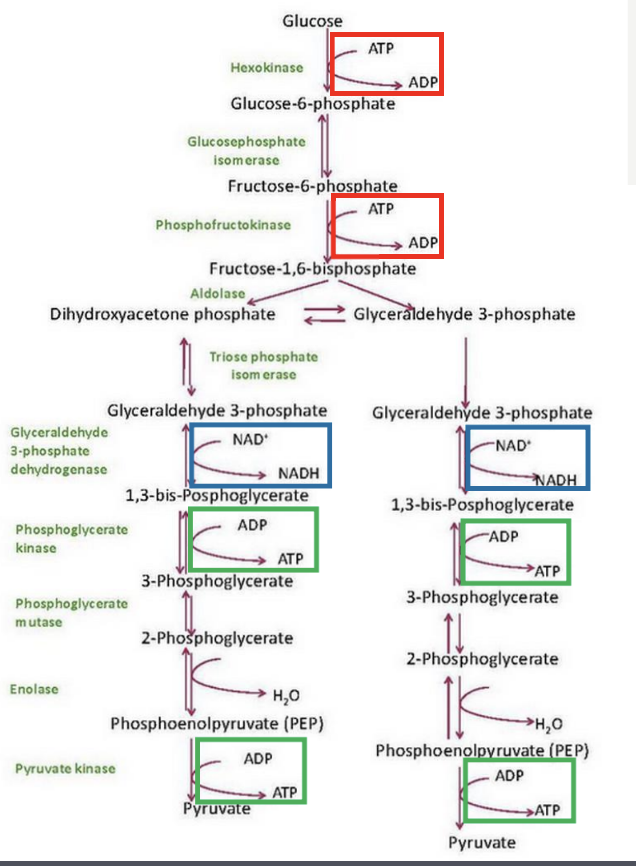
What is glycolysis?
substrate level phosphorylation is a metabolic pathway that converts glucose into pyruvate, producing ATP and NADH in the process.
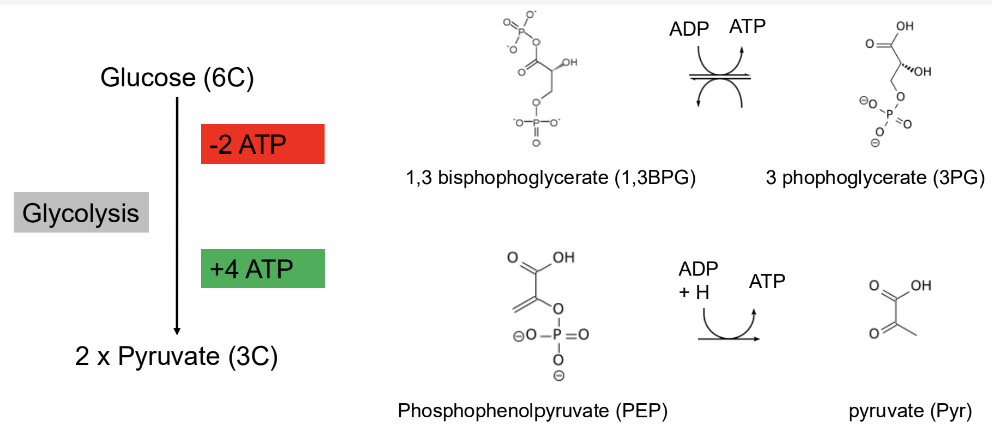
Where does oxidative phosphorylation occur in the cell and what is required for it?
Oxidative phosphorylation occurs in the mitochondria and requires O2.
What happens during oxidative phosphorylation?
ATP is regenerated from ADP and Pi (inorganic phosphate) via the electron transport chain
NADH and FADH2 donate electrons into the chain to facilitate ATP regeneration
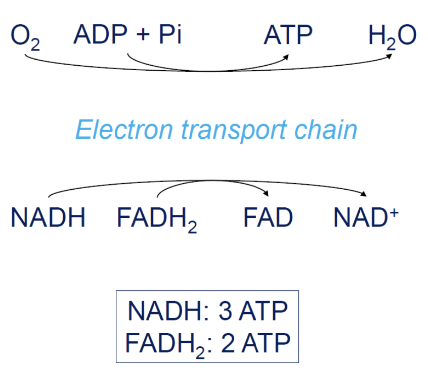
How many ATP molecules are generated from each NADH and FADH2 molecule during oxidative phosphorylation?
Each NADH will result in three ATP, and each FADH2 will result in two ATP.
adenine nucleotides are components of many enzyme cofactors - they are required for…
cellular respiration and energy metabolism
What is Nicotinamide Adenine Dinucleotide (NAD+) derived from?
Nicotinamide is derived from vitamin B3/niacin.
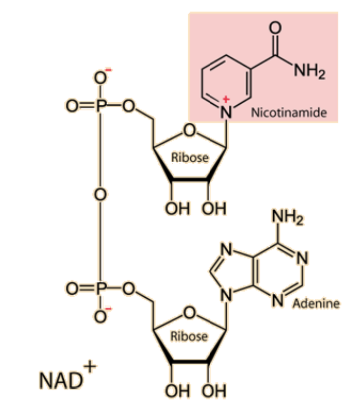
Using the OILRIG mnemonic, describe the conversion of NAD+ to NADH.
Oxidation Is Loss
Reduction Is Gain
N within the nicotinamide of NAD+ gains two electrons and also gains a proton (H+) - now reduced to NADH
When NADH is oxidised it loses the electrons and proton - now oxidised to NAD+
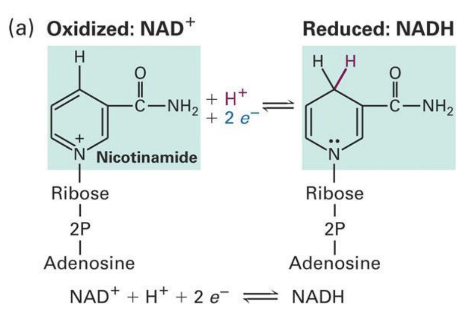
why does OILRIG of NAD+ vs NADH play an important role in oxidative phosphorylation?
because it generates 3 ATP from ADP and Pi
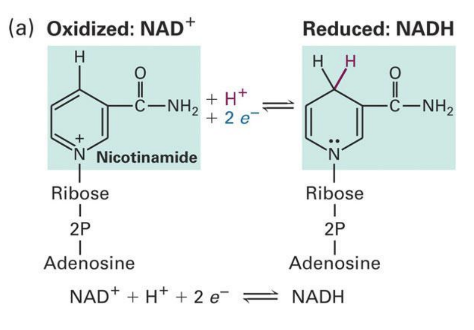
What is Flavin Adenine Dinucleotide (FAD(H2)) derived from?
Riboflavin is derived from vitamin B2
Using the OILRIG mnemonic, describe the conversion of FAD to FADH2.
Two N within the riboflavin of FAD gains two electrons and two protons H+ now reduced to FADH2
When FADH2 is oxidised it loses the electrons and protons - now oxidised to FAD
Important role in oxiddative phosphoylation cos generates 2 ATP from ADP and Pi
OILRIG
oxidation: loss of electrons
reduction: gain of electrons
reducing agent is the electron donor
oxidising agent is electron acceptor
What is the primary difference in structure between NADP+ and NAD+?
NADP+ has an additional phosphate group on the hydroxyl group of the 2'C, whereas NAD+ does not.
Is NADPH involved in oxidative phosphorylation or ATP regeneration?
No, NADPH is NOT involved with oxidative phosphorylation and has no role in ATP regeneration.
List four crucial roles of NADPH in the cell.
Reductive biosynthesis (e.g., fatty acids), protection against oxidative stress, phagocytosis, drug metabolism (e.g., cytochrome P450), and nitric oxide synthesis.
How is NADP+ regenerated to NADPH?
NADP+ is regenerated by the oxidative phase of the Pentose Phosphate Pathway (PPP).
What is Acetyl CoA's significance in cellular respiration?
It is a central point of metabolism and the first stage of cellular respiration, involving acetyl CoA production from macromolecules like carbohydrates, lipids, and proteins.
What happens to Acetyl CoA in the second stage of cellular respiration?
Acetyl CoA feeds into the citric acid cycle (TCA), producing NADH and FADH2.
What is the average theoretical number of ATP molecules generated from one glucose molecule during aerobic metabolism?
Theoretically ~36-38 ATP molecules, though actual numbers may be 30-32 due to transport costs.
Why is lactate production important during anaerobic metabolism?
Lactate production helps regenerate NAD+ from NADH, allowing glycolysis to continue and produce a limited amount of ATP in the absence of oxygen.
What is the net ATP yield from one glucose molecule during anaerobic metabolism?
2 ATP molecules.
What happens to lactate produced during anaerobic metabolism?
Lactate is transported to the liver, converted back to pyruvate, which can then be used to make new glucose via gluconeogenesis in the Cori cycle.
What is cyclic AMP (cAMP) and how is it produced?
cAMP is a common second messenger produced from ATP in a reaction catalyzed by adenylate cyclase (AC).
Name two other regulatory nucleotides besides cAMP.
Cyclic GMP (cGMP) and Guanosine tetraphosphate (ppGpp).